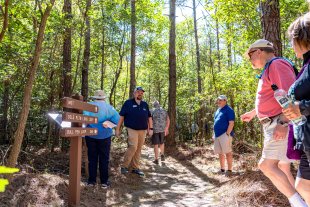
As we break ground on a new one-mile section of trail this month at Bentonville Battlefield State Historic Site, we wanted to introduce you to those working on the ground to make this possible. Derrick S. Brown is the Operations Manager at Bentonville Battlefield. He, site director Colby Stephens, and their hard-working staff have been instrumental in the development and maintenance of the MST and other trails at Bentonville.
Derrick has worked at Bentonville since 2006 and been operations manager since 2009. He received a BS from Western Carolina University in 2003 and a MA in History from UNC-Wilmington in 2010. Derrick is from Sneads Ferry (another trail hotspot!) and currently resides with his wife and two children in nearby Duplin County. Derrick is also the co-author of Bentonville Battlefield State Historic Site, an Images of America book, which shares the photographic history of the work to preserve the site post-Civil War.
We’ve asked Derrick to answer a few questions that help define our very strong partnership. We’re thrilled to keep adding more miles of trail in southern Johnston County!
1 – How does the Battlefield fit into the MST Community? How do we work together?
Bentonville Battlefield is a proud partner of the MST. The state administers over 2,000 acres here on the battlefield which provides greenspace for the MST. We need trails for access to historic areas off the beaten path and the MST provides us the logistical and financial support to get that done. In turn the battlefield provides a way for MST hikers to get off the highways. A perfect symbiotic relationship.
2 – How has the relationship between the MST and the Battlefield evolved/grown/changed from when you first got involved?
When I arrived at Bentonville our trail system paled in comparison to other battlefields of comparable size to us. We did have a single .4 mile trail and shortly began to build more. This was slow going before the MST because we had limited equipment, funding, and most importantly knowhow. This has all changed since our partnership with the MST. We have grown to over 6 miles of trail, most of which is along the MST.
3 – What challenges do you see in developing/maintaining the MST in your area?
Our biggest challenge is a good one to have. It is the sheer volume of trail that we now have and how to go about maintaining it with a full-time maintenance staff of 1. MST and other volunteers are crucial for us to maintain and continue to expand.
4 – How does the MST benefit your community? What community impact does it have?
The MST benefits Bentonville by bringing people to the battlefield who may not necessarily be considered “traditional visitors,” those who are not necessarily history nerds like me. Bentonville has become a destination for not only battlefield stompers but nature lovers and hikers alike.
5 – What have you been most excited about, or what gives you hope, when working on the MST?
I remain super excited about the trail that was built by the MST and the Friends of Bentonville Battlefield south of Harper House Road in the area the soldiers called the “Bull Pen.” It was such an inhospitable area for visitors that I doubted it ever being opened to the public during my tenure at Bentonville. This partnership made it happen.
6 – Do you have a favorite spot on the MST?
My favorite spot on the MST in Bentonville is our boardwalk over a small creek just east of the visitor center area on the historical Reddick Morris farm. It is shady, secluded, and quiet which belies the fact that thousands of soldiers jousted for control of Morris’s farm in March 1865. I particularly like it when the water is flowing under the boardwalk after a rain. That has not been the case much in the summer of 2024.
(Photo courtesy of NC Division of State Historic Sites – Derrick, in blue, is leading a hike on the MST near the Bull Pen)


